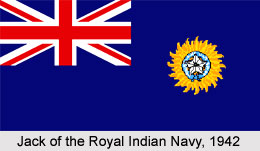 The Royal Indian Navy was the naval force of the British government of India. The Royal Indian Navy (RIN) was amongst the Armed Forces of the British Empire in India, along with the Presidency armies, the British Indian Army and the Indian Air Force from the year 1932. The Royal Indian Navy was established as the Marine of the British East India Company in the year 1612. The Navy gradually experienced several changes and developed to a great extent. The name was also changed a few times, such as the Bombay Marine, Her Majesty`s Indian Marine, Her Majesty`s Indian Navy and the Royal Indian Marine. Finally in the year 1934, it was renamed as the Royal Indian Navy. But until advent of World War II, the Royal Indian Navy remained a relatively small force, but later it expanded to a great extent.
The Royal Indian Navy was the naval force of the British government of India. The Royal Indian Navy (RIN) was amongst the Armed Forces of the British Empire in India, along with the Presidency armies, the British Indian Army and the Indian Air Force from the year 1932. The Royal Indian Navy was established as the Marine of the British East India Company in the year 1612. The Navy gradually experienced several changes and developed to a great extent. The name was also changed a few times, such as the Bombay Marine, Her Majesty`s Indian Marine, Her Majesty`s Indian Navy and the Royal Indian Marine. Finally in the year 1934, it was renamed as the Royal Indian Navy. But until advent of World War II, the Royal Indian Navy remained a relatively small force, but later it expanded to a great extent.
After the country achieved independence from the British Dominion and the Partition of India into the Unions of India and Pakistan in the year 1947, the assets and personnel of the former Royal Indian Navy were divided with the newly formed Royal Pakistan Navy. Almost two thirds of the armada was held by the Union of India, as did all land assets within its territory. This modified force, which was still known as the Royal Indian Navy, officially became the navy of the Dominion of India until the nation became a republic on 26 January, 1950. Later it was again renamed as the Indian Navy.
History of Royal Indian Navy
The British East India Company was formed in the year 1599 and it created a fleet of combating ships in 1612. Later the British constructed a port and established a small naval base at Suvali near Surat in Gujarat, in order to protect the various trade routes. The force was named as Honourable East India Company`s Marine by the British East India Company. On 5th September 1612, the first combating ships arrived at the port. The Honourable East India Company`s Marine protected merchant shipping in theNarmada and Tapti rivers and off the Gulf of Cambay. The marine fleet also helped map the coastlines of India, Arabia and Persia.
In the year 1686, with most of British commerce shifting to Bombay, the navy was renamed as the Bombay Marine. Later in the year 1830, the Bombay Marine was renamed as the Indian Navy, which participated in the First Opium War in the year 1840. After the culmination of the rule of the British East India Company in India as a consequence of the Sepoy Mutiny in 1857, the Navy came under the administrative control of the British government of India. It was again formally renamed as Her Majesty`s Indian Navy. In the year 1934, the Royal Indian Marine changed its name, with the enactment of the Indian Navy (Discipline) Act of 1934. On 2 October, 1934, the Royal Indian Navy was officially inaugurated at Bombay (now Mumbai).
Royal Indian Navy Mutiny
In February 1946, several native sailors initiated the Royal Indian Navy Mutiny on board more than 50 ships, as well as in shore establishments. It aimed to protest against the supposed discrimination against Indian sailors and officers by the British authorities during the war. The Royal Indian Navy Mutiny was supported by all and spread all over the nation, including the Air Force and the Army. Around 78 ships, 20 shore establishments and 20,000 sailors were involved in the Navy mutiny.
Royal Indian Navy after Indian Independence
After the Indian independence and the ensuing formation of 2 separate nations of India and Pakistan due to the Partition of India, the Royal Indian Navy was split between the newly formed Union of India and Dominion of Pakistan. The ships and men of the Royal Indian Navy were divided between India and Pakistan by the Armed Forces Reconstitution Committee. The ships were divided on the basis of two thirds of the fleet to India, one third to Pakistan.
Ships of Royal Indian Navy
The list of ships of the Royal Indian Navy is mentioned as follows-
Auxiliary Patrol Vessels
* HMIS Jamnagar
Harbour Tankers
* HMIS Chilka
Minesweepers
* HMIS Bihar (J247)
* HMIS Bombay (J249)
* HMIS Baluchistan (J182)
* HMIS Bengal (J243)
* HMIS Deccan (J129)
* HMIS Kathiawar (J155)
* HMIS Bengal (J243)
* HMIS Carnatic (J199)
* HMIS Madras (J237)
* HMIS Malwa (J55)
* HMIS Orissa (J200)
* HMIS Rajputana (J197)
* HMIS Rohilkhand (J180)
* HMIS Khyber (J190)
* HMIS Konkan (J228)
* HMIS Kumaon (J164)
* HMIS Oudh (J245)
Sloops
* HMIS Cornwallis (L09)
* HMIS Godaveri (U53)
* HMIS Hindustan (L80)
* HMIS Narbada (U40)
* HMIS Sutlej (U95)
* HMIS Cauvery (U10)
* HMIS Clive (L79)
* HMIS Kistna (U46)
* HMIS Lawrence (L83)
* HMIS Indus (U67)
* HMIS Jumna (U21)
Corvettes
* HMIS Sind (K274)
* HMIS Tir (K256)
* HMIS Assam (K306)
* HMIS Gondwana (K348)
Amphibious warfare ships
* HMIS El Hind (F120)



















